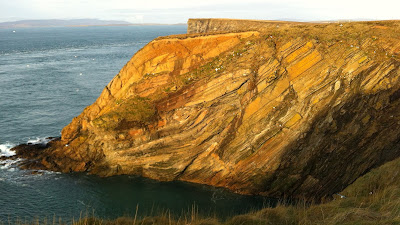Over recent days, Our Lass and I have explored a few more beaches, as wind and rain have allowed.
On New Year's Day, we ventured across to the east side of South Ronaldsay, to the Bay of Newark. The tide was in, leaving only a small strip of sand at the top of the beach, which we joyously shared with storm-strewn seaweed and a host of waders, the latter busily searching the former for morsels of food.
A gale was urging the incoming waves to put more effort into crashing onto the beach, so between the sea spray and the wind-blown sand, I was quite nervous of my optics. Indeed, in only a short time, the neutral filter on the object lens was coated with salt. There was so much action, I didn't know which way to look first: Long-tailed Ducks and Red-breasted Mergansers were feeding in the breakers; Turnstone, Redshank, Purple Sandpiper, Ringed Plover and Sanderling were scurrying between the incoming tide and the drift line; and, at one end of the beach were several photogenic structures, a church, the remains of a windmill and a couple of sets of rusted winding gear. Predictably, I tried to do everything at once and failed miserably, but it was an exhilarating location and will be well worth another visit.
 |
| Waders (US - Shorebirds) |
 |
| Sanderling and Turnstone |
 |
| Purple Sandpiper |
In one corner of the cemetery adjoining St Peter's church, were several recumbent grave stones which were decorated with memento mori in the form of a skull and crossed bones motif. My understanding is that this form of grave decoration is to remind us of our mortality and dates from the 1700s. More research required, methinks.
Above the bay, on the slope of a hillside, was a large monolith, the 14' high Sorquoy standing stone. There wasn't any other Neolithic structure visible in the landscape with which to relate it. Perhaps there used to be something under the present day church?
 |
| I'm not brave enough to caption this one |
The following day, we explored the dunes and beach adjacent to the 4th Churchill Barrier. Again this was around the time of high tide and the beach faced into the wind, so discretion being the better part of valour, I left my camera at home. If anything, we found ourselves in the midst of even more bird life, and closer! Drat and double drat.
At the northern end of the beach was a low grass-covered cliff. This was providing shelter and food for several flocks of Twite and Rock Pipit, with a couple of Wrens joining in for good measure. The beach itself was home to plenty of waders, but we were busy watching the huge waves that were crashing onto the shore. After a while, Our Lass nudged me and pointed to her left, where she had spotted a movement amongst the seaweed strewn at the top of the beach. With the naked eye, I couldn't immediately see what was there, but with the aid of my bins, a small flock of Snow Bunting materialised, about seven birds, busy searching the ground for food. Damn my caution in leaving the camera behind.
Today, on a somewhat calmer morning, we returned with optics in the hope of a repeat performance, but to no avail.
 |
| So this is what everything is eating? |
 |
| Waders evading radar |
Then, late this afternoon and sans camera again, we pottered up the hill behind the cottage, to investigate the view. As the south western horizon began to turn pink with the setting sun and a crescent moon glowed faintly, a tiny dot in the sky caught my attention.

Even at a great distance, the flap, flap, flap, glide... flap, flap, flap, glide... was unmistakeable. A Sparrowhawk. As I directed Our Lass onto it, I noticed something else in the sky behind it, a tiny thin crescent. Hang on, we have one of those already, I thought, and lowered my bins to check on the location of the Moon. Sure enough, there it was, just about where we'd left it, so who was the interloper? I guessed either Venus or Jupiter, but I had to wait until we were home to confirm that it was the latter*. Predictably, and by that point I was reunited with Very Wrong Len, the sky had clouded over. Some days there just aren't enough expletives.
* 06/01/14 Today I received an email from Captain Sundial, informing me that Venus will show phases, but Jupiter won't. After re-checking the direction we were facing in the above photo, the relevant OS map and a planet visibility app, I can now confidently say that it was Venus. We were facing SW, not SE, and it was the setting Venus, rather than the rising Jupiter. Sorry, Capt S, my humble apologies :o(































